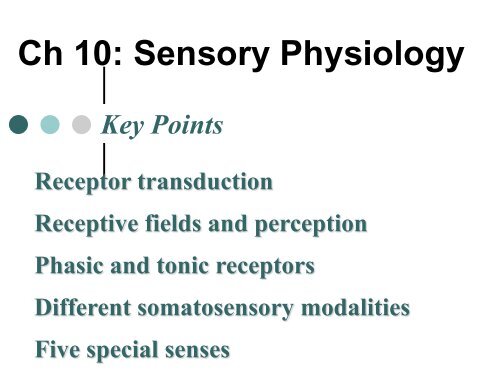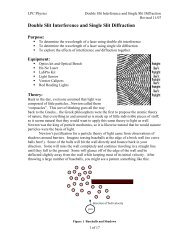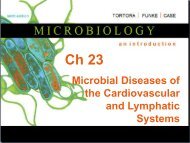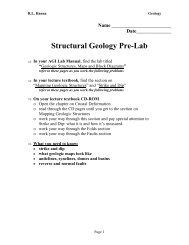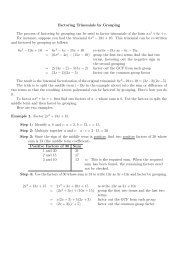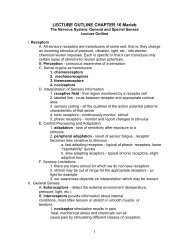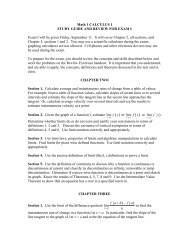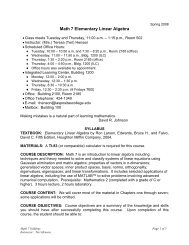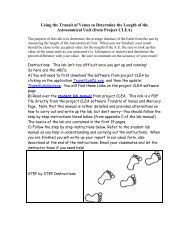Chapter 10: Sensory Physiology
Chapter 10: Sensory Physiology
Chapter 10: Sensory Physiology
Create successful ePaper yourself
Turn your PDF publications into a flip-book with our unique Google optimized e-Paper software.
Ch <strong>10</strong>: <strong>Sensory</strong> <strong>Physiology</strong>Key PointsReceptor transductionReceptive fields and perceptionPhasic and tonic receptorsDifferent somatosensory modalitiesFive special senses
<strong>Sensory</strong> Receptors - Overview are transducers → convert stimuli intograded potential (receptor potential) are of various complexity react to particular forms of stimuli• Chemoreceptors• _____________• _____________• _____________Fig <strong>10</strong>-1
<strong>Sensory</strong> TransductionConverts Stimulus into gradedpotential = receptor potential. Howis stimulus energy transduced?Receptor potential in neuron abovethreshold APReceptor potential in non-neuralreceptors changes influence onNT release
Receptive FieldsEach 1° sensory neuron picks upinformation from a receptive fieldOften convergence onto 2° sensoryneuron summation of multiple stimuliSize of receptive field determinessensitivity to stimulus Two pointdiscrimination test (see lab)Fig <strong>10</strong>-3Fig <strong>10</strong>-2
<strong>Sensory</strong>PathwayStimulus<strong>Sensory</strong> receptor (= transducer)_______________________CNSIntegration, perception
<strong>Sensory</strong> InfoPathways andCNS IntegrationSomatosensorycortexFig <strong>10</strong>-4
CNS Distinguishes4 StimulusProperties Modality (nature) ofstimulus Location (lateralinhibition & populationcoding) Intensity DurationFig <strong>10</strong>-<strong>10</strong>Somatosensory cortex
Intensity & Duration ofStimulus Intensity is encoded by # of receptors activatedand frequency of AP coming from receptor Duration is coded by duration of APs insensory neurons Sustained stimulation leads to adaptation• Tonic receptors do NOT adapt or adapt slowly• Phasic receptors adapt rapidly
Tonic Receptors vs. Phasic Receptors Slow or no adaptation Rapid adaptation Continuous signaltransmission forduration of stimulus Monitoring ofparameters that mustbe continuallyevaluated, e.g.:barorecptors__________ ? Cease firing if strengthof a continuousstimulus remainsconstant Allow body to ignoreconstant unimportantinformation, e.g.:___________?Fig <strong>10</strong>-8
Somatic Senses Primary sensory neuronsfrom receptor to spinal cordor medulla Secondary sensoryneurons always cross over(in spinal cord or medulla) thalamus Tertiary sensory neurons somatosensory cortex(post central gyrus)Fig <strong>10</strong>-9
Touch ReceptorsFree or encapsulated dendritic endingsIn skin and deep organs. e.g.:Pacinian corpusclesconcentric layers of c.t. large receptivefield detect vibrationopens mechanicallygated ion channelrapid adaptation receptor type?
Temperature Receptors Free dendritic endings in hypodermis Function in thermoregulation Cold receptors (< body temp.) Warm receptors (> body temp.) Test if more cold or warm receptors in lab Nociceptors Adaptation only between 20 and 40C
Nociceptors Free dendritic endings Activation by strong, noxious stimuli - Function? 3 categories:• Mechanical• Thermal (menthol and cold / capsaicin and hot)• Chemical (includes chemicals from injured tissues) May activate 2 different pathways:• Reflexive protective – integrated in spinal cord• Ascending to cortex (pain or pruritus) Fast (A) vs. slow pain (C) (review axon diameter,myelination)
Referred PainPain in organs ispoorly localizedMay be displaced ifMultiple 1° sensoryneurons convergeon single ascendingneuronFig <strong>10</strong>-13
Fig <strong>10</strong>-14Chemoreception: Smell and Taste2 of the five special sensesVery old (bacteria use to sense environment)Olfaction Olfactory epithelium has 1,000 differentodorant receptors Bipolar neurons continuously divide! G-protein – cAMP mediated Brain uses “population coding” todiscriminate 1,000s of odors
Gustation Organ for taste = ?See Fig <strong>10</strong>-15Taste buds located inpapillae contain groupof taste andsupport cells
Taste Buds: Five taste sensationssour5) __________?Phasic receptors ______ adaptation!
Each tastecell issensitiveto only onetasteCa 2+ signalreleases NTFig <strong>10</strong>-16
Sour and Salt Ligands
Special Senses: Hearing &BalanceReview Ear anatomy•outer•middle•innerHearing: organ of cortiBalance: maculae and cristae ampullaris
SoundtransmissionSound wavesTympanic membrane vibrationsOssicles transmit & amplify vibrationVia oval window to perilymph then endolymph
cont.Vibrations inendolymph stimulatesets of receptor cellsNT release of receptorcell stimulatesnearby sensoryneuronImpulse to auditorycortex of temporallobe via________________nerve
Fig <strong>10</strong>-21Hearing Transduction= multi-step process:air waves mechanical vibrations fluidwaves chemical signals APsAt rest ~ <strong>10</strong>% ofion channelsopenMore ionchannels open:ExcitationAll channelsclosed:Inhibition
Signal Transduction cont.At restExcitiationInhibition
Interpretation of Sound Waves:Pitch Perception Sound wave frequency expressed in Hertz(Hz) = wavelength / sec Human can hear between 20 and 20,000 Hz High pitch = high frequency Low pitch = low frequency Tone = pure sound of 1 frequency (e.g.tuning fork)
Basilar MembranePitch perception is functionof basilar membraneBM stiff near oval windowBM more flexible near distalendBrain translates location onmembrane into pitch of sound→Temporal aspects of frequencyare transformed into spatialcoding→ Spatial coding is preserved inauditory cortexCompare to Fig <strong>10</strong>-22
Interpretation of Sound Waves:Loudness perceptionRate at which APs are fired loudness Sound Intensity Measurement:Decibel Scale (dB) starts at 0 and is logarithmic 130 dB pain threshold > 80 dB frequently or prolonged ? Examples:• noisy restaurant ~ 70 dB• rock concert ~ 120 dB
2 (3) types of Hearing LossConduction deafnessExternal or middle earMany possible etiologiesOtitis media, otosclerosis etc….Sensorineural deafness (+ central)Damage to neural structures (from receptors tocortical cells)Most common: gradual loss of receptor cells
Equilibrium= State of Balance• Utricle and saccule(otolith organs) withmaculae (sensory receptors)for linear acceleration and head position• Semicircular canals and ampullae withcristae ampullaris (sensory receptors) forrotational acceleration• Important besides inner ear: input fromvision & stretch receptors in muscle
Otolith Organs of Maculae Maculae andCristaampullarisreceptors similarto organ of cortireceptors However: gravity& accelerationprovide force tomove stereo cilia Fig <strong>10</strong>-25
Not in bookMotion Sickness= Equilibrium disorderDue to sensory inputmismatchExample?Antimotion drugs (e.g.: Dramamine):Depression of vestibular inputs
VestibularNystagmus = Reflex movement via input fromsemicircular canals & cristae ampullaris As you rotate• eyes slowly drift in opposite direction (due to backflowof endolymph)• then rapid eye movement in direction of rotation toestablish new fixation point Continues until endolymph comes to rest Sudden stop ?
VisionReview eye anatomyespecially:Path of light througheyeballCellular layers of retinaIntrinsic eye musclesBlind spot and foveacentralis
Vision Process can be Dividedinto Three Steps1. Light enters eye, is focused bylens onto retina2. Photoreceptorstransduce lightenergy intoelectrical signal
3. Electrical signals sent along neuronalpathways are processed in visual cortex
Light Modification Pre-Retina• Amount of light is changed by alteringpupil aperture from 1.5 – 8 mm• Pupillary constriction due to ?• Dilation ?• Pupillary reflex isconsensual
The LensLight is focused bychanging lens shapeRefraction: Due to differentdensities, light waves arebent, or refracted whenpassing from onemedium into another
Accommodation: Light is focused (to keepobjects in focus) by changing lens shapeLens attached to ciliary muscle viasuspensory ligament (= zonulas)Ciliary muscle contractsSee also Fig <strong>10</strong>-32. . . . . .Lens bulges upFig <strong>10</strong>-31
Vision Problems Presbyopia (loss of accommodation) Myopia (near-sightedness) Hyperopia (far-sightedness) Astigmatism (asymmetry of corneaand/or lens)Test of visual acuity in lab
Compare to Fig <strong>10</strong>-33
Important concept from 1 st part of chapter:<strong>Sensory</strong> Transduction ConvertsStimuli into Graded PotentialsStimulus energy is transduced into amembrane potential change.How can you create an excitatory orinhibitory signal?
Phototransduction atRetinaAnatomy review:Neurons organized into layers
Light = Electromagnetic EnergyWavelengthfor visiblelight: =?Someanimalscan see UVand IRwaves
Photo-ReceptorsRods Monochromaticnight time vision 1 pigment(Rhodopsin) Most numerous except in foveaCones High acuity vision & daytime color vision 3 pigmentsFig <strong>10</strong>-38
Phototransduction forRhodopsinRetinal absorbs 1photonRhodopsin splits:Retinal is releasedfrom opsin due toconformationalchange(similar for cone pigments)= “bleaching”How does this produce AP ?Retinal = Vit.A derivativeOpsin = protein
No Light:Rhodopsin inactiveCells have membranepotential of ~ - 40mV (what does thatmean, what is it dueto ?)Fig <strong>10</strong>-39Continuous (= tonic)NT release toadjacent bipolarcells
Light:Rhodopsin splitsActivation of transducin( = __? - protein)2 nd messenger cascadedecreases cGMPlevelsNa + channels close ?NT release decreases
120 Mio rods 6 Mio cones only 1.2 Mio axons enter optic nerve mechanism?Visual processingin visual cortexOptic nerves enterbrain at opticchiasma: somefibers cross sides right side visualfield to left sidebrain
Visual Field and BinocularVision3 vs. 2 dimensional viewFig <strong>10</strong>-41


